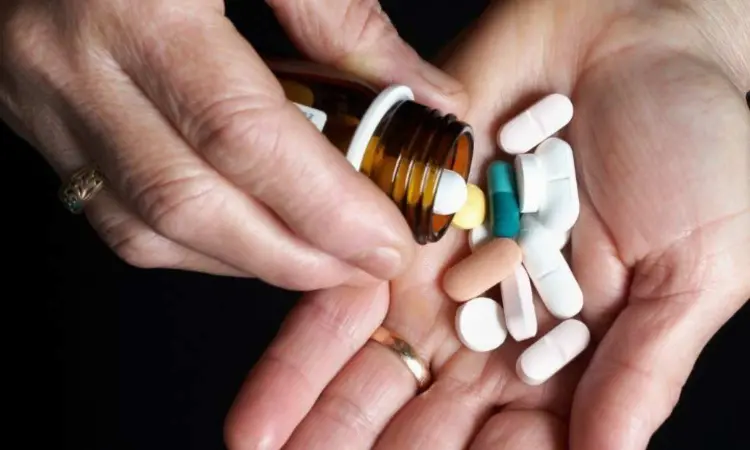- Home
- Medical news & Guidelines
- Anesthesiology
- Cardiology and CTVS
- Critical Care
- Dentistry
- Dermatology
- Diabetes and Endocrinology
- ENT
- Gastroenterology
- Medicine
- Nephrology
- Neurology
- Obstretics-Gynaecology
- Oncology
- Ophthalmology
- Orthopaedics
- Pediatrics-Neonatology
- Psychiatry
- Pulmonology
- Radiology
- Surgery
- Urology
- Laboratory Medicine
- Diet
- Nursing
- Paramedical
- Physiotherapy
- Health news
- Fact Check
- Bone Health Fact Check
- Brain Health Fact Check
- Cancer Related Fact Check
- Child Care Fact Check
- Dental and oral health fact check
- Diabetes and metabolic health fact check
- Diet and Nutrition Fact Check
- Eye and ENT Care Fact Check
- Fitness fact check
- Gut health fact check
- Heart health fact check
- Kidney health fact check
- Medical education fact check
- Men's health fact check
- Respiratory fact check
- Skin and hair care fact check
- Vaccine and Immunization fact check
- Women's health fact check
- AYUSH
- State News
- Andaman and Nicobar Islands
- Andhra Pradesh
- Arunachal Pradesh
- Assam
- Bihar
- Chandigarh
- Chattisgarh
- Dadra and Nagar Haveli
- Daman and Diu
- Delhi
- Goa
- Gujarat
- Haryana
- Himachal Pradesh
- Jammu & Kashmir
- Jharkhand
- Karnataka
- Kerala
- Ladakh
- Lakshadweep
- Madhya Pradesh
- Maharashtra
- Manipur
- Meghalaya
- Mizoram
- Nagaland
- Odisha
- Puducherry
- Punjab
- Rajasthan
- Sikkim
- Tamil Nadu
- Telangana
- Tripura
- Uttar Pradesh
- Uttrakhand
- West Bengal
- Medical Education
- Industry
Enclomiphene citrate significantly increases total and apparent free serum testosterone among men with secondary hypogonadism

Clomiphene citrate is used to induce ovulation in women. However, clomiphene given to men fails to produce consistently increases in sperm count. This drug is a mixture of two geometric isomers with different properties. Enclomiphene citrate (the trans- or (E)-isomer) has effects consistent with estrogen antagonism whereas zuclomiphene citrate (the cis- or (Z)- isomer) often acts as an agonist. Most preparations of clomiphene contain an unequal mixture of the isomers with a predominance of enclomiphene (60%). The clearance of each isomer from the blood differs with zuclomiphene persisting longer than enclomiphene. Authors reasoned that isomer composition, differences in half-life, and the divergent biological end points could contribute to the dichotomous effects in men and women.
It was a randomized, double-blind, placebo- and active-controlled study in hypogonadal men. Oral enclomiphene citrate in doses of 12.5 mg (n10), 25 mg (n11), and 50 mg (n11) compared to placebo (n10) and AndroGel® 1% (5.0 G) (n10) were administered for 14 days. Subjects at screening had low or borderline low (99–343 ng/dL) total serum testosterone levels with normal LH and FSH levels. On the first day of treatment, men in the study had total serum testosterone (TT) levels of 275 ± 88 ng/dL (mean ± SD).
After 14 days of treatment, there was a dose-dependent rise in TT levels with enclomiphene: 12.5 mg per day was associated with a level of 412 ± 194 ng/dL; 25 mg per day with 520 ± 160 ng/dL, and 50 mg per day with 589 ± 172 ng/dL, values in the normal range (298 to 1034 ng/dL). AndroGel® 1% (5.0 G), the active control, resulted in a level 473 ± 289 ng/dL, which is consistent with levels reported in the medical literature. All four treatments demonstrated statistically significant increases compared to day 1. The placebo group showed no increase in serum testosterone (mean change -1.2 ng/dL). AndroGel® 1% was also associated with a disproportionate rise in DHT relative to TT: The ratio of DHT to TT in men on AndroGel® 1% increased between day 1 and day 15 by a factor of 1.59. In comparison, men receiving placebo showed almost no change (1.07) and men on the highest dose of enclomophene had a lower ratio by a factor of 0.83. Apparent free serum testosterone levels measured by RIA demonstrated a dose-dependent rise in serum testosterone with enclomiphene whereas the placebo group did not increase.
Enclomiphene citrate (designated as Androxal™) significantly increased total and apparent free serum testosterone without increasing DHT proportionally. This new agent may represent a new oral modality for elevating testosterone in men with secondary hypogonadism.
Source: R. D. Wiehle, W. D. Garcia, M. S. Willett; FERTILITY & STERILITY
doi:10.1016/j.fertnstert.2004.07.221
MBBS, MD Obstetrics and Gynecology
Dr Nirali Kapoor has completed her MBBS from GMC Jamnagar and MD Obstetrics and Gynecology from AIIMS Rishikesh. She underwent training in trauma/emergency medicine non academic residency in AIIMS Delhi for an year after her MBBS. Post her MD, she has joined in a Multispeciality hospital in Amritsar. She is actively involved in cases concerning fetal medicine, infertility and minimal invasive procedures as well as research activities involved around the fields of interest.
Dr Kamal Kant Kohli-MBBS, DTCD- a chest specialist with more than 30 years of practice and a flair for writing clinical articles, Dr Kamal Kant Kohli joined Medical Dialogues as a Chief Editor of Medical News. Besides writing articles, as an editor, he proofreads and verifies all the medical content published on Medical Dialogues including those coming from journals, studies,medical conferences,guidelines etc. Email: drkohli@medicaldialogues.in. Contact no. 011-43720751


